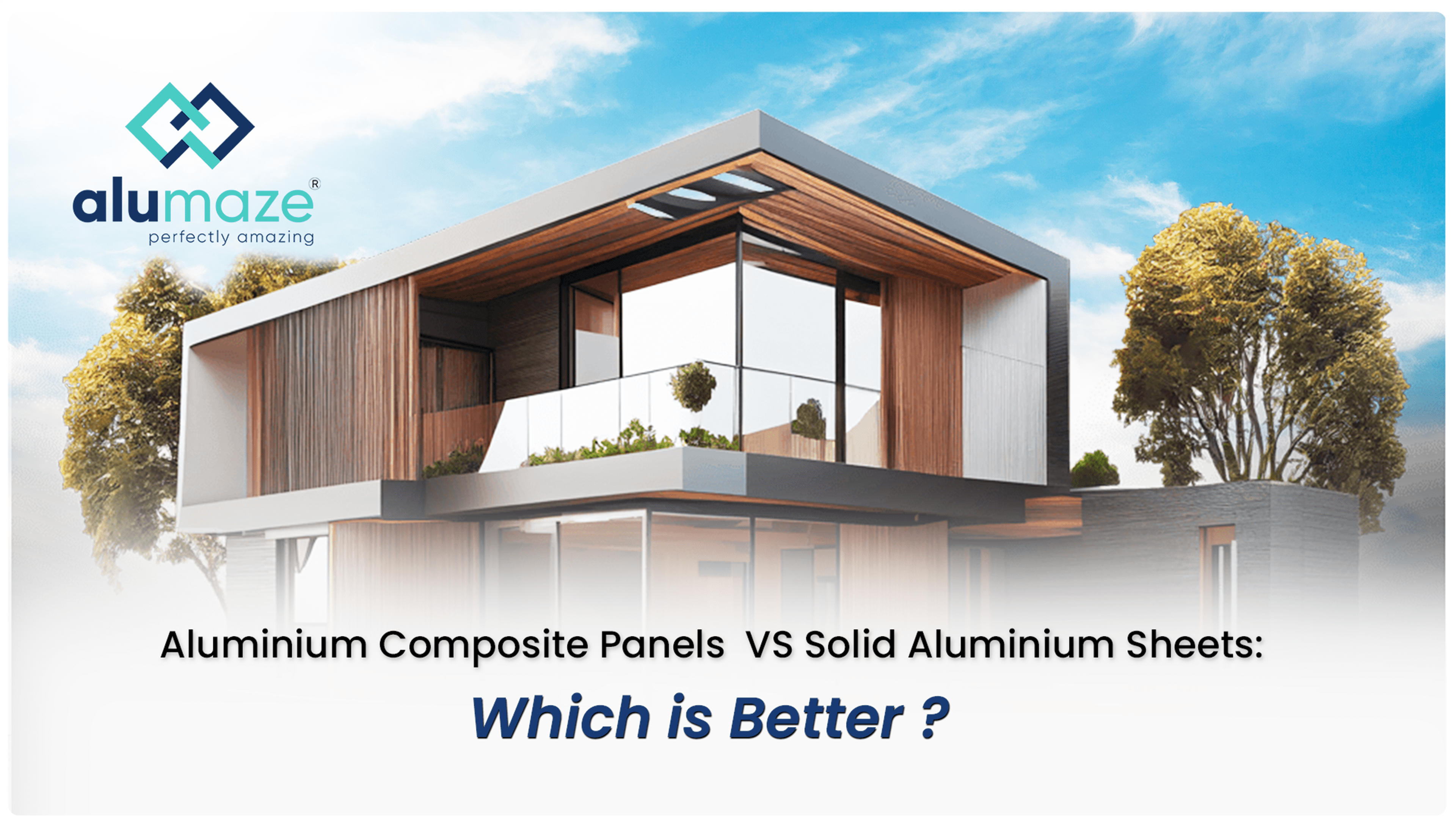The world of modern construction and architecture is constantly evolving, with materials becoming more sophisticated and versatile to meet the demands of contemporary design and functionality. Among the most popular materials in the construction industry, today are aluminium sheet material, which come in various forms, including Aluminium Composite Panels (ACPs) and Solid Aluminium Sheets.
Both materials have distinct properties and benefits that make them suitable for different applications. However, when it comes to selecting the right material for your project, understanding their differences is essential. In this blog, we will take a deep dive into Aluminium Composite Panels vs. Solid Aluminium Sheets, analyzing their advantages, disadvantages, and the best scenarios to use them, helping you decide which is better for your next project.
What is Aluminium Sheet Material?
Before we compare the two, it’s crucial to understand what aluminium sheet material is and why it has become so popular. Aluminium sheet material refers to flat, thin pieces of aluminium that are widely used in construction, manufacturing, transportation, and other industries due to their durability, lightweight, corrosion resistance, and versatility. These sheets come in various thicknesses and can be treated with finishes like anodizing or powder coating for enhanced durability and aesthetics.
Two of the most common forms of aluminium sheet material are Solid Aluminium Sheets and Aluminium Composite Panels (ACPs). Both materials are used in construction, but each serves different purposes, offering unique advantages depending on the application.
What Are Solid Aluminium Sheets?
Solid aluminium sheets are exactly what they sound like sheets made entirely of aluminium. They come in different thicknesses, or gauges, and can be used in a variety of applications, from roofing to cladding, facades, and even vehicle body parts.
Key Features of Solid Aluminium Sheets
Durability: Solid aluminium is strong, resistant to corrosion, and can withstand extreme weather conditions, making it suitable for outdoor applications.
Lightweight: Aluminium’s strength-to-weight ratio is one of its most celebrated properties. It is significantly lighter than other metals like steel, making it easier to handle and install.
Versatility: Solid aluminium can be cut, shaped, and welded, allowing for a wide range of applications.
Fire Resistance: Solid aluminium is non-combustible and provides excellent fire resistance, making it a safe option for exterior cladding.
What Are Aluminium Composite Panels (ACPs)?
Aluminium Composite Panels (ACPs) consist of two thin layers of aluminium that are bonded to a non-aluminium core, typically made of polyethylene or mineral-filled core materials. ACPs offer a lightweight yet durable alternative to solid aluminium sheets, widely used in cladding, signage, and interior applications.
Key Features of Aluminium Composite Panels (ACPs)
Lightweight: Thanks to their composite structure, ACPs are even lighter than solid aluminium sheets, making them easier to transport and install.
Design Flexibility: ACPs come in a wide variety of finishes, textures, and colors, giving architects and designers greater freedom to achieve their aesthetic goals.
Cost-Effective: ACPs are generally more affordable than solid aluminium sheets due to their composite structure, making them a budget-friendly choice for large-scale projects.
Thermal Insulation: The non-aluminium core of ACPs can offer better thermal insulation than solid aluminium sheets, enhancing energy efficiency in buildings.
Ease of Maintenance: ACPs are easy to clean and maintain, making them ideal for long-term projects that require minimal upkeep.
Key Differences Between Aluminium Composite Panels and Solid Aluminium Sheets
When deciding between Aluminium Composite Panels and Solid Aluminium Sheets, it’s important to consider the specific needs of your project. Here’s a breakdown of the primary differences between these two materials:
1. Weight and Handling
ACPs are significantly lighter than solid aluminium sheets due to their composite nature. This makes them easier to transport, handle, and install, especially in large-scale projects. Their lightweight nature also reduces the load on building structures, making them an ideal choice for high-rise buildings and other applications where weight is a concern.
Solid aluminium sheets, while still relatively lightweight compared to other metals, are heavier than ACPs. They may require more effort to install, especially when working with thicker sheets.
2. Durability and Strength
Solid aluminium sheets are more durable and can withstand more physical damage compared to ACPs. They are also highly resistant to corrosion, making them suitable for industrial applications and areas with extreme weather conditions. If structural strength is a top priority, solid aluminium sheets are the better option.
ACPs are durable but not as strong as solid aluminium sheets. The non-aluminium core is more prone to damage, especially in high-impact situations. However, advancements in ACP technology, such as fire-retardant cores, have improved their overall performance.
3. Aesthetic Appeal and Design Flexibility
ACPs excel in offering diverse design possibilities. They come in a wide variety of colors, finishes, and textures, such as metallic, wood grain, and even stone-like finishes. This makes them the preferred choice for architects and designers who want to create eye-catching exteriors or interiors.
Solid aluminium sheets, while available in various finishes, do not offer as many customization options as ACPs. However, they can be anodized or powder-coated to achieve different colors and finishes. Solid sheets are often used in industrial or minimalist designs that emphasize strength and simplicity over aesthetics.
4. Fire Resistance and Safety
Solid aluminium sheets are non-combustible and offer superior fire resistance, making them ideal for projects where fire safety is a primary concern. Solid aluminium does not release harmful gases or smoke in the event of a fire, contributing to safer building environments.
ACPs with a polyethylene core have been criticized for being less fire-resistant. However, fire-retardant ACPs with mineral-filled cores have been developed to meet stringent fire safety standards. These fire-resistant ACPs are now widely used in high-rise buildings and other structures that require enhanced fire safety measures.
5. Cost-Effectiveness
ACPs are typically more affordable than solid aluminium sheets. Their composite structure means less aluminium is used, reducing overall material costs. ACPs are a cost-effective solution for large-scale projects, especially where budget constraints are a concern.
Solid aluminium sheets are generally more expensive due to the higher amount of aluminium used. While they offer greater strength and durability, the increased cost may not always justify their use, especially in aesthetic applications where ACPs can provide a similar look at a lower price.
6. Thermal and Acoustic Insulation
ACPs provide better thermal and acoustic insulation compared to solid aluminium sheets due to their non-aluminium core. This makes them a preferred choice for energy-efficient buildings where maintaining indoor temperature and reducing noise pollution are important.
Solid aluminium sheets do not offer the same level of insulation. If energy efficiency or noise reduction is a priority, additional layers of insulation may be required when using solid aluminium sheets.
7. Environmental Impact
Both ACPs and solid aluminium sheets are recyclable, contributing to sustainability in construction. However, ACPs with polyethylene cores are more difficult to recycle compared to those with fire-retardant mineral cores. The aluminium in both materials can be recycled indefinitely, reducing the demand for virgin aluminium.
8. Maintenance
ACPs are easy to clean and maintain, thanks to their smooth surfaces and resistance to dirt and grime. Regular washing with water is often enough to keep them looking new. This makes ACPs ideal for commercial buildings that require long-term, low-maintenance solutions.
Solid aluminium sheets are also relatively low-maintenance but may require occasional polishing or coating reapplication, especially in harsh environmental conditions.
Which is Better: Aluminium Composite Panels or Solid Aluminium Sheets?
The answer depends on your project’s specific requirements. Aluminium Composite Panels (ACPs) are the best choice for projects that require lightweight materials, aesthetic versatility, cost-effectiveness, and energy efficiency. They are perfect for cladding, signage, interior design, and other non-structural applications.
On the other hand, Solid Aluminium Sheets are better suited for projects that prioritize strength, durability, fire resistance, and long-term performance in harsh conditions. If you are working on an industrial project or a high-traffic area that requires high-impact resistance, solid aluminium sheets may be the ideal solution.
Both Aluminium Composite Panels and Solid Aluminium Sheets offer unique advantages, making them indispensable in modern construction and design. Your project’s needs should guide your choice between these two materials in terms of weight, durability, aesthetics, fire safety, cost, and insulation.
For architects, builders, and designers, understanding the distinct properties of these materials is crucial for making informed decisions. By weighing the pros and cons, you can ensure that your project not only meets structural requirements but also achieves aesthetic and functional excellence. Whether you choose ACPs for their design flexibility or Solid Aluminium Sheets for their robustness, both materials represent the future of modern construction, shaping skylines and interiors worldwide.



[…] means that aluminium constitutes about 30%-50% of the total weight of an ACP panel. The thickness of the aluminium layers can vary, usually ranging from 0.2 mm to 0.5 mm, while the […]
Good info. Lucky me I found your bloog by chane (stumbleupon).
I’ve saved it for later!